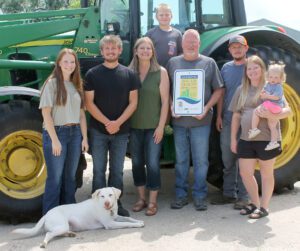|
|

Lyman Paulsen (center) is this year’s Pipestone County Conservationist of the Year. He’s pictured here with his family at the family farm southeast of Hatfield. Pictured (l-to-r) are his daughter-in-law Taylor, son Nicholas, wife Roxanne, grandson Aiden, Paulsen, son Nathan, daughter-in-law Amanda and granddaughter Shaylee. In front is Nicholas’ and Taylor’s dog, Luna. Photo by Kyle Kuphal
Lyman Paulsen has been named this year’s Pipestone County Conservationist of the Year. He said it came as a surprise when he found out a few weeks ago that he’d been selected to receive the honor.
Paulsen and his wife, Roxanne, live southeast of Hatfield and grow corn, beans and oats. Their son, Nick, farms with them and raises stock cows and chickens.
About nine years ago they switched one portion of the land they farm to no-till with a corn and bean rotation. The rest of their land is strip tilled in the fall for corn and not tilled for beans. Over the last year, they’ve also planted cover crops on all the acres they farm, using a multi-species mix.
In addition to that, they recently reshaped a waterway with assistance from the Natural Resources Conservation Service (NRCS) and Pipestone County Soil and Water Conservation District, and Nick has done rotational grazing for his cattle for three years. Paulsen’s farm became a certified water quality farm last year.
Paulsen said Nick has been influential in the family’s implementation of conservation practices. Nick said he started learning about no-till at Lake Area Technical College in Watertown. Then he started reading books about it after a neighbor recommended one. From there, he said, it was “down the rabbit hole.” His conclusion: “More soil health is better for the farm and it’s better for us,” Nick said.
Since implementing the various conservation practices, Paulsen said he’s cut costs, saved time, and seen no difference in production. Economically, it’s made sense.
“The fuel and time savings is just unbelievable,” Paulsen said.
He said the ground is firmer with strip tilling and no tilling, which makes it easier to get equipment through. He’s noticed a difference in water infiltration as well. He recalled driving home from Pipestone last year after the heavy rains early in the summer and seeing standing water in fields along the way. There was no standing water in their fields and he believes it was due to the conservation practices they’ve implemented and increased worm activity.
Paulsen said some farmers are hesitant to change from the way they’ve always done things, but that he would recommend the use of conservation practices to others. He said the NRSC and SWCD have programs available that can help.
“It’s very well worth trying,” Paulsen said.
With the honor of being named the conservationist of the year, Paulsen has the opportunity to attend the annual Minnesota Association of Soil and Water Conservation Districts convention and trade show in Minneapolis in December. There, he and other outstanding conservationists from around the state will be recognized.


